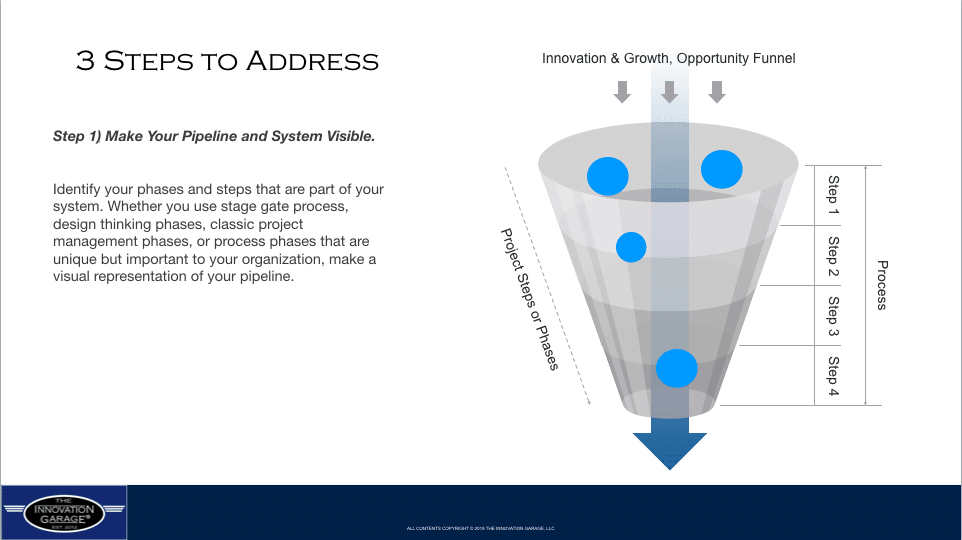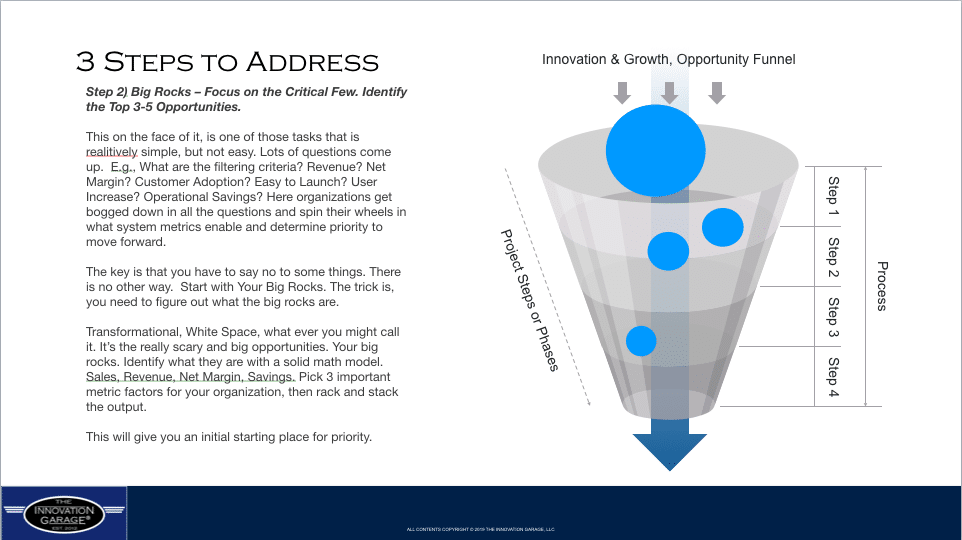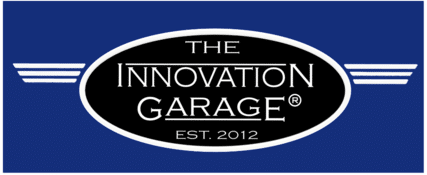“If the big rocks don’t go in first, they aren’t going to fit later.” – Steven R. Covey
One of the common FAQ topics we support with our clients and collaborators is;
“How do you actually manage all the innovation, growth and project management activity in a project pipeline? “
So, to level set, and create some common ground, here’s an example of your typical pipeline, or opportunity funnel.

Most organizations that ask the question fall into three distinct segments or “organizational personas.” Each time, where they land on their challenges, is directly based on on what is going on within the organization.
First, some organizations have a pipeline that has run dry. There is just a simple need to fill the pipeline. Easy enough. With some creativity sessions, you create ideas, build them up, and provide a quick jumpstart. Then, it’s off to the races on execution.
Second, some organizations have plenty of ideas, but execute extremely slowly due to the mindset and/or organizational inertia they have. This is a tough place to be. Most times, there is not a good process in place to prioritize and identify where next to start. We call this being stuck in the execution trap.
Meaning, that they have so many ideas and activities, they don’t know what opportunities are the biggest strategic priorities.The likely cause here is lack of alignment to organizational strategies, and blind spots to exactly what is in the pipeline.
Many times, the projects are aged quite significantly (sometimes years), or the project may have been a pet project of an specific executive, or the organization can’t exactly remember why certain projects were important in the first place.
Finally, other organizations might be stuck in being idea rich and execution poor. They love to generate tons of ideas, and they are very good at it. But prioritization, focus, and the very real fear of execution locks them up. They can’t (or will not) move forward. Sometimes this is a direct result of the senior leaders not wanting to take any project risks that would result in a project failure. As a failure may directly and negatively impact their career aspirations beyond their current role.
An analogy is when you first learn to skydive. No matter how good your instructor, training, systems, insight and data analysis are, you still have to personally get over your own fear of the initial jump and exit the aircraft.
All are very common use cases. But with each, there steps that, as one of our advisory team members says, create the necessary traction to deliver a “high speed & low drag” pipeline system.
Regardless of where you might find yourself, here are 3 insights and approaches that you can apply. This will help get a handle on the challenges of pipelines and visual management needed to get moving. As we said, it’s pretty simple, but not necessarily easy.
Step 1) Make Your Pipeline and System Visible.

Identify your phases and steps that are part of your system. Whether you use stage gate process, design thinking phases, classic project management phases, or process phases that are unique but important to your organization, make a visual representation of your pipeline.
Step 2) Big Rocks – Focus on the Critical Few. Identify the Top 3-5 Opportunities.

This on the face of it, is one of those tasks that is realitively simple, but not easy. Lots of questions come up. E.g., What are the filtering criteria? Revenue? Net Margin? Customer Adoption? Easy to Launch? User Increase? Operational Savings?
Here organizations get bogged down in all the questions and spin their wheels in what system metrics enable and determine priority to move forward. Start with Your Big Rocks.
The trick is, you need to figure out what the big rocks are.
Transformational, White Space, what ever you might call it. It’s the really scary and big opportunities. Your big rocks. Identify what they are with a solid math model. Sales, Revenue, Net Margin, Savings. The key is that you have to say no to some things. There is no other way.
Pick 3 important metric factors for your organization, then rack and stack the output. This will give you an initial starting place for priority.
Step 3) “Flip the Funnel”

Now that you have the Big Rocks…don’t make the Big Rock smaller by chipping away at them. Flip the funnel, and work backwards.
Size the exit opening of the funnel for your biggest opportunity, and as first priority get to work on that. Starting with the customer and working backwards. We know this sounds counter intuitive, but we assure you it works.
IF you pick a big rock first, you are automatically pressure testing the size of your funnel. You’ll learn what you need to support the bigger opportunity from a systems perspective. From this you can then get to work on the other opportunities as they materialize. If you do want a small scale test, once you have the funnel opening sized for that big opportunity, you can dial it back and move a smaller project thru the big opening funnel as a test.
We’re confident that in the blend of the three approaches, you can create something pretty meaningful. It will resonate across your organization. These tactics will be understood by senior leaders AND your operational teams.
This will, as Steven R. Covey says, free you with space to create process and traction. Then comes execution. Which by the way, if you don’t know by now is the really really hard part. So, we’ll save the topic of the big “E” of execution for our next articles.
If you are looking to get some reps on how to apply these approaches, that are meaningful AND align to your organization’s growth goals, here are three ways you can learn more:
Leading for Growth Webinar – 11 April 2019 12:15PM EST
Sign up and join The Innovation Garage® for this webinar to understand what it takes for your organization to mange pipelines and funnels more effectively.
Innovation & Growth Breakfast Session – Thursday 18 April 2019
8:30AM-10:30AM EST
We’re back with our friends at Baldwin Wallace University’s Center for Innovation & Growth. Get together with local organization innovators to share best proactices, network and learn. In this 2 hour session, we’ll cover some basics on strategy for innovation, and share our learnings and best practices for those considering building their organizations internal capability to grow.
Innovation 101 Workshop – Wednesday 22 May 2019 9:00AM-4:00PM EST
A 1 Day session that provides the basics on Innovation that will help you in your daily work. RIGHT NOW! – No matter your skill, title, or experience.
Everyone Can Innovate – NOW.
No matter your role in the organization, being more innovative means you can create, communicate, and accelerate ideas for anything. At this 1 day program workshop you’ll experience the fundamentals of the innovation necessary for creating front end ideas for products, processes, and services.
In this workshop you’ll learn the very basics on:
-
- How to create ideas and problem solve (with methods 8x more effective than brainstorming).
-
- How to communicate ideas in a way that builds them up and sells.
-
- How to take an idea from inspiration to reality – FAST
-
- MindMapping (Basics as an innovation acceleration tool)
-
- Innovation Basics Systems Skills (Create – Communicate – Commercialize)
- Design Thinking Introductory Skills (Empathy – Define – Ideate – Prototype – Test)
Innovation Quickstart 360 3 Day Workshop
11-13 June 2019 9:00AM-4:00PM EST
Igniting Teams for Growth!
Join The Innovation Garage® at Baldwin Wallace University’s Center for Innovation and Growth in Cleveland, for this 3 Day innovation & growth training, followed by an optional 60-day mentoring AND certification program.
QUICK START 360 IS A BLENDED 3 DAY INNOVATION TRAINING, FOLLOWED BY AN OPTIONAL 60 DAY CERTIFICATION PROGRAM THAT MAKES INNOVATION & GROWTH POSSIBLE, PRACTICAL AND EASY.
This real world and pressure-tested program has been designed and proven to give you the essential know how, tools and step-by-step instruction manual necessary for innovation success.
In this course, you’ll spend 3 days of In-Depth Learning of advanced Innovation & Growth Skills. Diving deep in methods on how to Lead, Facilitate and problem solve solutions using;
- Techniques to better Understand People, Process, & Tools Necessary for Growth
- Organizational Mindset and application of Neuroscience for both individuals and teams
- Leading Behaviors to create Psychological Safety that is critical for Innovation & Growth
- Systems Thinking applied to Innovation & Growth.
- Facilitation Skills for Structured Creativity Sessions
- Application of advanced Mind Mapping Skills
- Application of Innovation Systems Advanced Skills
- Methods to Build Teams and Lead Collaboration with Others
- Methods to Apply Design Thinking Advanced Skills & Tools
- Methods to Apply & Understand HFX Principles for Hack-A-Thon Design & Development
- Methods to Apply & Understand CX principles to better understand the customer journey
So, Join us… and get to work on creating the capability needed for your organization’s growth.
#mindset #strategy #leadership #innovation #growth
We help organizations grow. We build strategy. We build ideas and coach innovation capability of teams. We design products, services and supply chains. We guide leaders from non-profit, government, startup and the Global Fortune 50 to intentionally self-disrupt their offerings and organizations. We provide world class education, tools and technology on how to craft business operating systems focused on long- term growth. To learn more visit us here ,check out our calendar of events, or reach out to us and discuss a private program for your organization.
